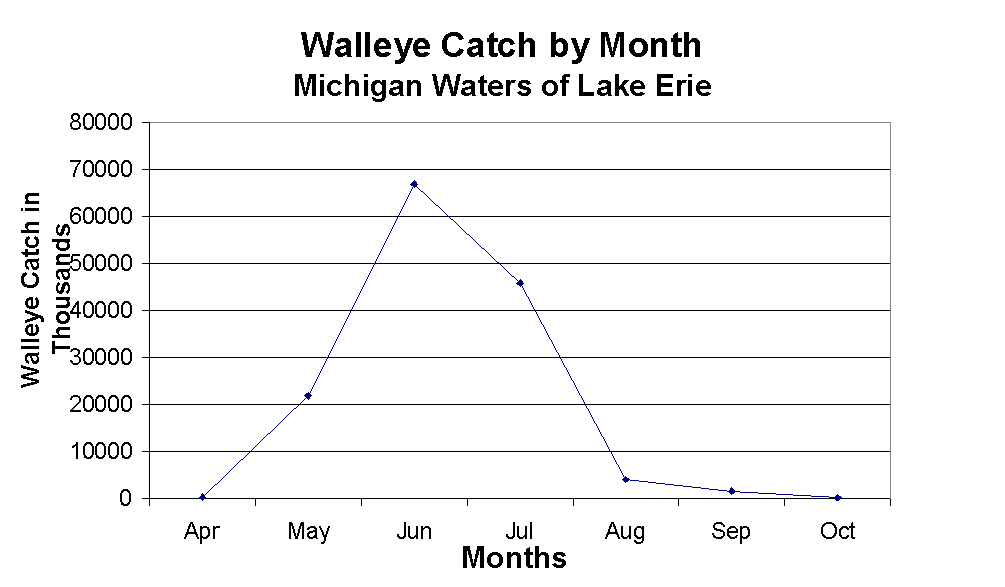
Chart 1.
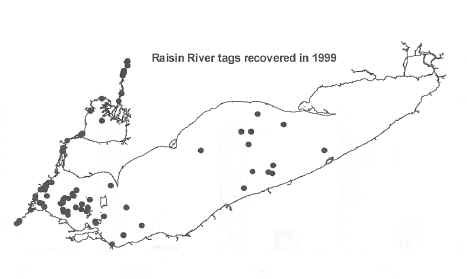
Figure 1
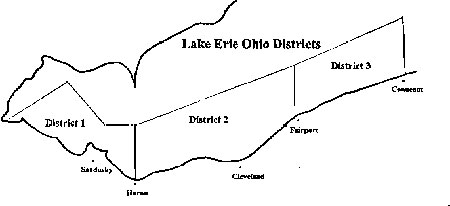
Figure 2.
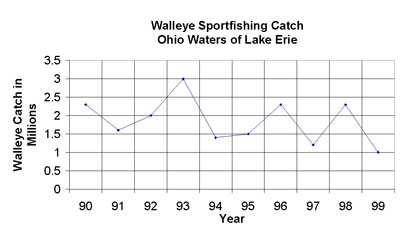
Chart 2
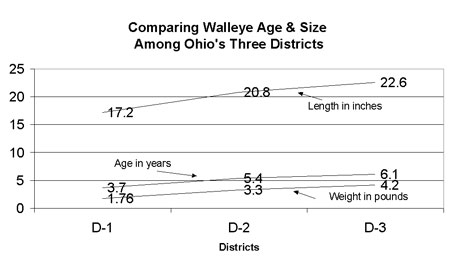
Chart 3
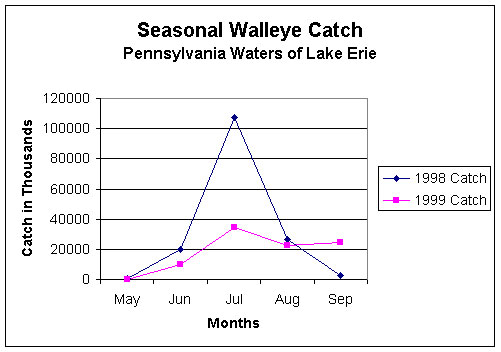
Chart 4
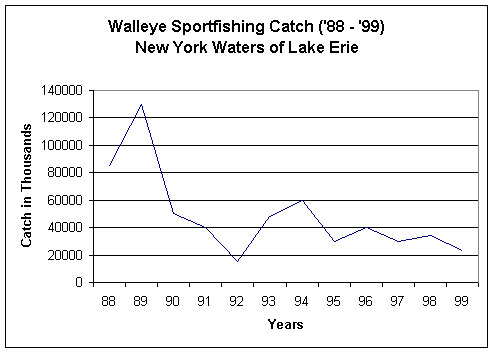
Chart 5

Chart 6
The 2000 Lake Erie Walleye Report
by Rick Kubb
I
n each summer issue of Lake Erie Walleye Magazine, we provide a synopsis of the walleye fishery in Lake Erie based on the scientific reports produced by the fisheries management biologists from the states of Michigan, Ohio, Pennsylvania and New York. We’ll report on the estimated size of the walleye population in Lake Erie, walleye growth and migration, catch rates, and other biological factors related to the walleye fish stocks in Lake Erie.Walleye Quotas
The Lake Erie Committee of the Great Lakes Fishery Commission for the second year in a row has reduced the total allowable catch (TAC) of walleyes. The TAC for 2000 has been set at 7.7 million fish, down 12 percent from the 1999 TAC of 9 million fish. The 1998 TAC was higher still at 10.3 million fish.
The cause for this reduction was a projected decline in lakewide abundance of walleye in 2000. The estimated abundance of two year old and older walleye is an estimated 50 million fish which is 14 percent lower than the estimated abundance of 57 million fish in 1999.
Ohio and Ontario receive the majority of the walleye TAC. Of the 2000 TAC of 7.7 million walleyes, Ohio’s share is close to 4 million fish, about 51 percent of the TAC. Ontario’s share of the TAC is about 3.3 million fish, or about 43 percent. The remaining estimated 6 percent of the TAC is divided among Michigan, Pennsylvania and New York waters of Lake Erie.
Michigan Waters of Lake Erie
In 1999 anglers harvested an estimated 140,268 walleyes from the Michigan waters of Lake Erie. Of these, a total of 90,542 walleyes were taken by private anglers (64.5%) and 49,726 fish were taken by charter boat anglers (35.5%). Charter boat angler catch rates for walleyes were over four times greater than those of private anglers.
Walleye fishing peaked in the month of June with 66,832 fish caught. A total of 45,795 fish were caught in the month of July. June and July accounted for over 80% of the total walleye catch. Walleye fishing dropped off rapidly in August (see chart 1) as anglers turned their effort toward yellow perch.
In 1999 age 2 and 3 (’97 & ’96 year classes) walleyes dominated the harvest, comprising 74% of the catch. Age 2 walleyes averaged 14 inches and age 3 fish averaged 16.2 inches. Age 4 walleyes only contributed 16% of the total catch.
Angler effort in 1999 increased slightly from the levels of 1998 but remain low compared to the effort observed in the early 90s.
In 1999 a total of 2,716 walleyes were tagged by Michigan and New York fisheries biologists at two Lake Erie sites. The Michigan site was the Raisin River. Sixty-three of those tags were recovered by fishermen for a single season reporting rate of 2.3%. This inter-agency tagging study will continue to provide valuable information regarding walleye movements throughout the lake. Figure 1 indicates the locations where Raisin River tagged walleyes were recovered in 1999. Fish from the Raisin River tag site moved as far east as Erie, Pennsylvania, bordering the eastern basin of Lake Erie.
Ohio Waters of Lake Erie
In studying the walleye dynamics of the Ohio waters of Lake Erie, fisheries biologists divide the area into three distinct "Districts" (See figure 2). District 1 is considered the western basin while Districts 2 & 3 make up the central basin of Lake Erie.
In 1999 private anglers harvested a total of .7 million walleye, down considerably (59% decrease) from the 1.7 million fish taken in 1998. Targeted effort of 2.7 million angler hours was also lower (by 21%) compared to 1998. The lake-wide estimated catch rate for private anglers was .25 walleye per angler hour, a decrease of 49% from 1998. In total, just over 1 million fish were caught in Ohio waters of Lake Erie in 1999, a significant decrease from the 2.3 million fish caught in 1998 (chart 2).
In 1999 the charter boat fishery harvest of .3 million fish was a 44% decrease from 1998. The targeted catch rate of .54 fish per angler hour was lower than 1998 but comparable to the historical date of the 90s.
The majority of the walleye catch in 1999 was from the 1997 and 1996 year classes. Age-5 and older walleye constituted 35% of the lake-wide catch. The average age and size of walleye caught when combining all three Ohio districts was 4.1 years, 18.1 inches and 2.2 pounds. Fish age and size increased from west to east. Walleyes were older and larger in District 3 compared to Districts 1 & 2 (chart 3). In district 3 the average age of walleye caught was 6.1 years old compared to 5.4 years in District 2 and 3.7 years in District 1. The average size in inches was 22.6 inches in District 3, 20.8 inches is District 2 and 17.2 inches in District 1. Average size in pounds was 4.2 pounds in District 3, 3.3 pounds in District 2 and 1.8 pounds in District 1. The trend of older and larger fish from west to east is well established and re-occurs each year.
Pennsylvania Waters of Lake Erie
In 1999 the estimated abundance of walleyes in Pennsylvania waters was 670,000 walleyes, an increase from the 1998 estimate of 570,000 walleyes. Biologists estimate that about 15% of these walleyes will be caught this year which should result in an estimated total harvest of about 100,000 walleyes.
A creel survey of Pennsylvania anglers indicated that the 64 percent of Lake Erie fishermen targeted walleyes. Less effort was given to smallmouth bass (16%) and stealhead trout (9%) and yellow perch (6%).
In 1999 walleye angler effort was estimated to be close to 400,000 hours, a 2% increase over 1998. This angler effort peaked in July and August. However, there was a 200% increase in the amount of angling for walleyes that occurred in the month of September in 1999, over the previous year.
In 1999 anglers caught an estimated 92,467 walleyes. This was a 41% decrease in catch from the 1998 catch of 157,000 walleyes (chart 4). The walleye catch peaked in July (34,733 fish). The August catch was an estimated 22,770 walleyes. The 1999 season was prolonged resulting in a large September catch of 24,573 walleyes. Catch rates of walleyes in Pennsylvania waters were down in 1999 (0.2 fish/line hour) compared to 1998 (0.26 fish/line hour). The majority of Pennsylvania walleyes were taken in the central basin waters west of Presque Isle.
The average sized walleye caught in Pennsylvania waters in 1999 was 21.9 inches. This is slightly higher than the average size taken in 1998. Three year old walleyes dominated the catch in 1999 (30%)
The commercial fishery in Pennsylvania waters of Lake Erie has all but disappeared. There remains only a single licensee fishing trap nets. A total of only 229 pounds of walleye was reported in 1999. The commercial fishery for walleyes peaked in 1995 at 42,138 pounds and has fallen off dramatically since. Sport fishermen harvest ninety-nine percent of all walleyes.
The round goby continues to rapidly spread eastward along the shores of Lake Erie. Pennsylvania biologists report that the round goby density has increased from less than 1 goby/hectare in 1997 to over 1,000 gobies/hectare in 1999.
New York Waters of Lake Erie
In 1999 the sport fishing angling effort in New York Waters of Lake Erie was an estimated 455,317 angler hours, down considerably from the 605,394 hours expended in 1998. This is the lowest boat fishing effort in the past twelve years. Last year also marked the first time that walleye was not the number one targeted species. In 1999, smallmouth bass angling ranked first in boat fishing effort on New York’s portion of Lake Erie. Walleye angling ranked second.
A total estimated walleye harvest was 23,134 fish, a relatively low harvest compared to the past several years (chart 5). The 1999 sport fishery for walleyes was centered in offshore waters between Dunkirk and Irving, New York,
Biologists believe two factors, weather and low lake levels partially contributed to the lower walleye fishing effort and catch in 1999. Biologists observed that poor weather conditions existed for many weekend days that could have slowed angler effort. Low lake levels made access at several boat ramps more difficult than in previous years.
Data cited in this report have been derived from the following reports:
1. Status of the Fisheries in Michigan waters of Lake Erie and Lake St. Clair, 1999. Michigan Department of Natural Resources Fisheries Division.
2. Ohio’s Lake Erie Fisheries, 1999. Lake Erie Fisheries Units, Ohio Department of Natural Resources. Division of Wildlife
3. Lake Erie Fisheries Status and Trends Report, 1999. Report to Lake Erie Committee. Lake Erie Research Unit, Pennsylvania Fish Commission.
4. Fish, Wildlife & Marine Resources. 2000 Annual Report, Bureau of Fisheries. Lake Erie Unit to the Lake Erie Committee and the Great Lakes fishery Commission. New York State Department of Environmental Conservation.

Chart 1. |

Figure 1 |

Figure 2. |
Chart 2 |

Chart 3 |

Chart 4 |

Chart 5 |

Chart 6 |